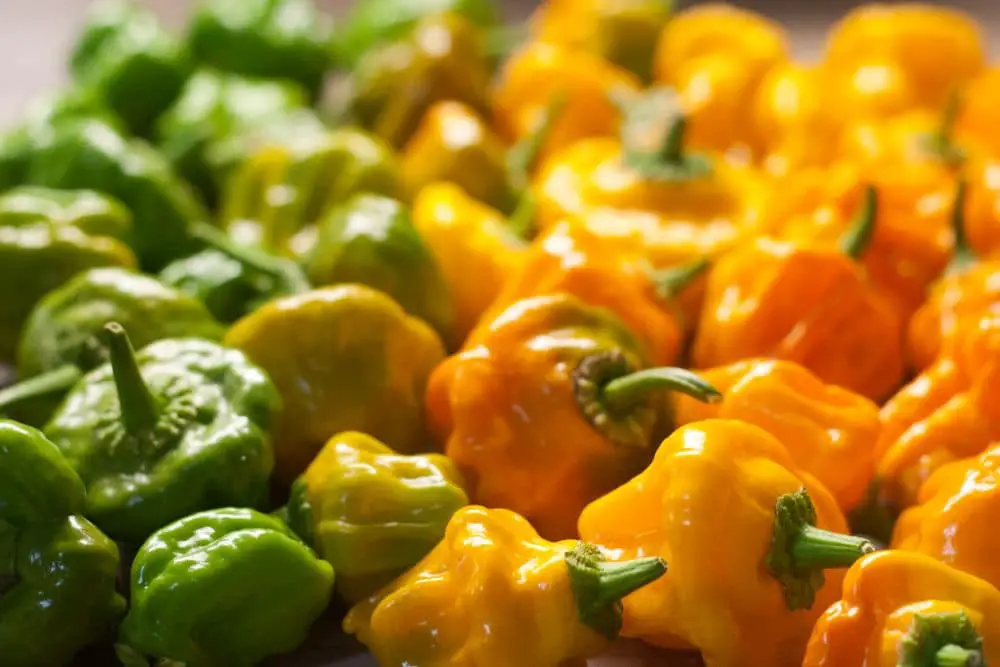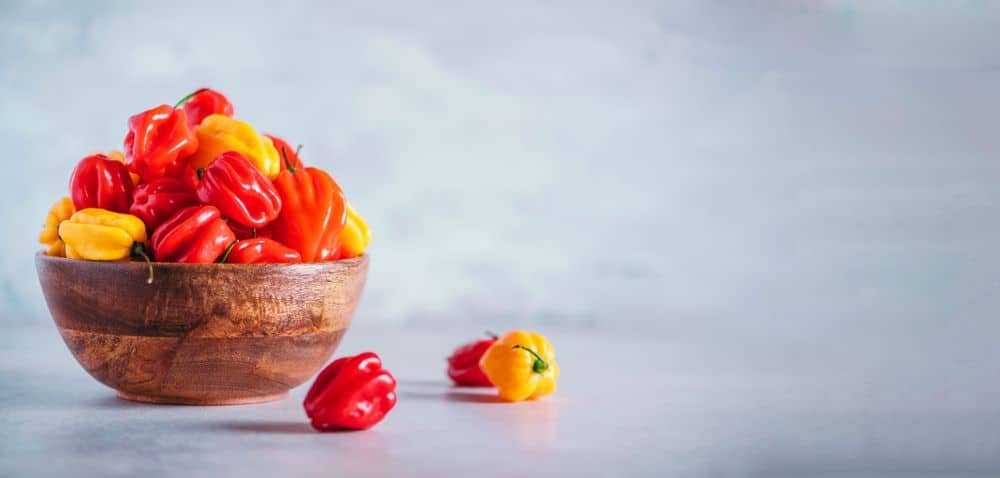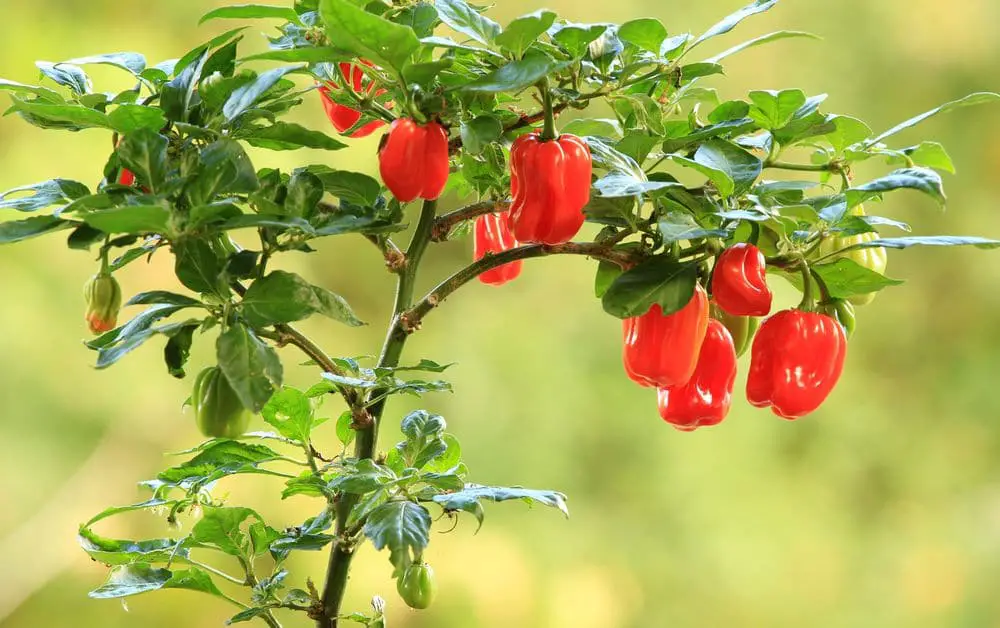Scotch Bonnet: 20 Interesting Facts: The name may sound harmless, but Scotch Bonnet Chili Peppers pack quite a lot of heat. How hot? Let’s find out and learn about this delicious and fiery hot pepper.
The Scotch Bonnet Pepper is largely used in the regions of Caribbean where it tends to show up in every form of cuisine that calls for a hot pepper. Below we’ve listed 20 Interesting Facts about the Scotch Bonnet Chili Pepper.
20 Interesting Facts about the Scotch Bonnet:
1. Scotch Bonnet peppers must be cooked in a well-ventilated kitchen because the vapors may interfere in the person’s breathing process.
2. When slicing the pepper, the eyes must be protected in a secured way.
3. The Scotch Bonnet pepper is one of the main ingredients in seasonings and sauces. When the Scotch Bonnet is not available, the Habanero pepper can be used as its substitute.
4. You must remove the seeds with the membrane inside the pepper carefully, because this is the heat storage place.
5. Chop the Scotch Bonnet pepper into fine pieces because the finer pepper spreads easily on the dish.
6. Absolutely avoid getting it on your skin – do not touch the Scotch Bonnet Pepper.
7. It tastes slightly sweet like a tomato with a slight hint of apples and cherries for which it is admired widely.
8. It’s essential to wear rubber gloves, the Scotch Bonnet Pepper should be handled properly and with respect.
9. Scotch Bonnet pepper contains capsaicin, which is used for manufacturing medications such as analgesic, pepper spray and circulatory stimulants.

10. It is used in flavoring and spices because of its spectacular color and flavorful aroma in African, American, Asian, European, and Australian cuisines including pepper recipes such as pepper sauce, hot sauces, and pepper soup.
11. Scotch Bonnet could be planted as a decorative and ornamental plant due to its colorful appearance especially when ripe.
12. Scotch Bonnet Peppers could be used for coloring food due to their strong colors such as paprika pepper, purple pepper, long red peppers, and cayenne peppers and more.
13. The Scotch Bonnet is an excellent source of phytochemicals and vitamins such as vitamin A, vitamin C (ascorbic acid), iron, vitamin B, carotenoids, niacin, riboflavin, dietary fiber, flavonoids, and magnesium.
14. It contains insecticidal properties thus can be used as a natural insecticide in farmlands and gardens for warding off insects.
15. The Scotch Bonnet pepper contains capsaicin, which has been revealed by researchers to be capable of preventing and blocking the growth of cancer cells. Capsaicin can suppress the growth of malignant cells and cellular metabolic activation.
16. It can be used as pain treatment due to the presence of capsaicin for treating different types of pain such as: rheumatoid pain, headaches, osteoarthritis pain, painful diabetic neuropathy and inflammatory heat.
17. Helps relieve chest congestion. This pepper could be used for preparing traditional medicines and soups that can be taken to relieve chest congestion and for preventing sinusitis.
18. It helps in the treatment of asthma. The roots of this type of pepper could be used in preparing traditional medicines for treating asthma.
19. The presence of capsaicin makes this pepper great for treatment of Cardiovascular Diseases. It reduces the onset of said diseases such as hypertension, coronary heart disease and atherosclerosis. This is achieved by simply inhibiting the aggregation of the platelets.
20. Weight Management. This is due to the capsaicin that the Scotch Bonnet pepper is capable of reducing excess body fats. If you want to shed any excess fat, don’t forget to include a reasonable amount of scotch bonnet peppers in your diet.
What is a Scotch Bonnet?
It is a chili pepper, a cultivar of the habanero and is among the hottest peppers. If you’ve ever tried a habanero pepper, you’ll know it carries some serious heat while the Scotch Bonnet is equally hot.
It measures at 100,000-350,000 Scoville Heat Units (SHU), compared to a jalapeno pepper. It averages to 5,000 SHU, and you’ll understand the heat level.

A Scotch Bonnet Chili Pepper is squat, with gnarled pods, averaging 2 to 7 centimeters in length and 2 to 5 centimeters in diameter.
It has a flattened, irregular shape with four prominent ridges. Its skin is waxy, wrinkled, and firm. It matures from green to yellow, orange, red, or brown, depending on the variety.
Beneath the surface, the flesh is crisp and pale green to yellow, red, orange, or brown, encasing a central cavity filled with small, round, and colored seeds.
Scotch Bonnet pepper has a sweet fragrance, fruity, and floral taste. A taste mixed with notes of cherries, tomatoes, and apples followed by intense, pungent heat.
Scotch Bonnet derives its name from the fact that its appearance resembles a Scotsman’s Bonnet with a squashed look. So, the name Scotch Bonnet seemed appropriate.
On the other hand, it was given of some other names like the Jamaican Hot, Bahama Mama, the Bahamian, and the Martinique pepper.
However, the tasty and fiery pepper can trace its roots to the lowland jungles of the western Amazon basin in what is now called Brazil.
Fire Starters
This fruity firecracker, the Scotch Bonnet packs an impressive amount of flavor into their fiery flesh. This pepper is known for its fruity taste, making it a popular ingredient across the Caribbean islands.
This capsicum is particularly well known for its mind-boggling amount of capsaicin – the naturally occurring chemical compound that gives chili pepper its kick.
In fact, the Scotch Bonnet is native to Western Africa, and likely found its way to the tropical islands aboard those same European ships.
Their popularity seems to spread right along with their seeds, and today, they are so popular with this hot sauce-favorite chili pepper.
Scotch Bonnet Taste
What does a Scotch Bonnet taste like? It has been described as having a slightly sweet taste. Quite a bit like a tomato with a hint of apples and cherries. Its sweetness makes this hot pepper a very popular chili for Caribbean cooking and hot sauces. It is an awesome pepper, a distinct sweet-heat flavor that a lot of people love.
The Scotch Bonnet is very closely related to the habanero. If you’ve tasted a habanero, you’ll have a great idea of what a Scotch Bonnet has in store for you in terms of heat. But Scott bonnet has more sweetness.
There are a lot of variants of Scotch Bonnet from the Tobago Scotch Bonnet to the Scotch Bonnet Chocolate and among others. Its flavor and heat, as with any chilies, would adapt to the region and the type of soil it is grown.
Chocolate and among others. Its flavor and heat, as with any chilies, would adapt to the region and the type of soil it is grown.
Therefore, Scotch Bonnet varieties slightly differ in spice and sweetness. Some are elongated rather than squat in shape. While the colors will range from orange-pink to chocolate-brown.
Heat Scale and Heat Rating of Scotch Bonnet.
It is said that a pepper is considered hot if it burns going in and burns coming out. Moreover, there are 2 scales of heat measurement. The Scoville and American Spice Trade Association (ASTA).
This Scoville Scale measures the concentration of capsaicin. It is the active compound responsible for pepper spice.
Capsaicin oil comes from the extracted dried pepper and is mixed with a solution of water and sugar. Wherein a panel of taste-testers can barely detect the heat of the pepper.
Such pepper is assigned Scoville units which are based on how much the oil was diluted with water to reach this point.
ASTA is using high-performance liquid chromatography. It accurately measures the concentration of spice-producing chemicals.
The Scotch Bonnet Pepper is a hot pepper with a rating of 100,000 to 350,000 units on the Scoville Scale. In the field of natural and human engineered peppers, the Scotch Bonnet rates 21 in ascending order of heat.
Rating at number 1 is the Carolina Reaper. It is engineered by combining peppers from St Vincent and Pakistan.
More Facts about Scotch Bonnet for Cooking:
Play Into the Tropical Flavor.
Scotch bonnet is known for their deliciously sweet, tropical flavor. Choose ingredients with flavors that complement the approach of pairings. Scotch bonnet works surprisingly well with earthy ingredients and adding a surprising sweet when none is expected.
Respect The Heat.
Scotch bonnet sits at the upper-end of spiciness for commonly used culinary chilies. You can find different kinds of peppers in supermarkets, if you’ve decided to try a scotch bonnet in a recipe that’s it. Not mixed up with others significantly decreases the amount used and ruins a meal.
Use Kitchen Gloves and Kitchen Goggles When Cutting Them Open.
You can definitely get chili burn simply by handling. Scotch Bonnets, but the true potential for pain comes from chopping these chilies. When the capsaicin oils are exposed, a simple touch can lead to an extremely uncomfortable burning sensation.
If you get it on your fingers and absentmindedly touch your face or eyes, it will cause you a lot of pain for hours afterwards.
The gloves help keep a barrier between you and those oils. Just add goggles to keep you from mistakenly rubbing your eyes while working with these chilies.
Final Thoughts on Scotch Bonnet: 20 Interesting Facts
We at Green Garden Tribe hope you find this article enlightening and are encouraged to enjoy eating dishes that contain Scotch Bonnet Chili Peppers as clearly, they are good for you. It’s inspiring to know that this one small pepper brings so many benefits!
Happy Gardening! Spread the love!
Read More:
Understanding The Scoville Unit (Measure the Pepper’s Heat)
Ghost Pepper Plant (All You Need to Know!)
15 Spiciest Peppers in The World. (No. 1 Will Blow You Away!)

